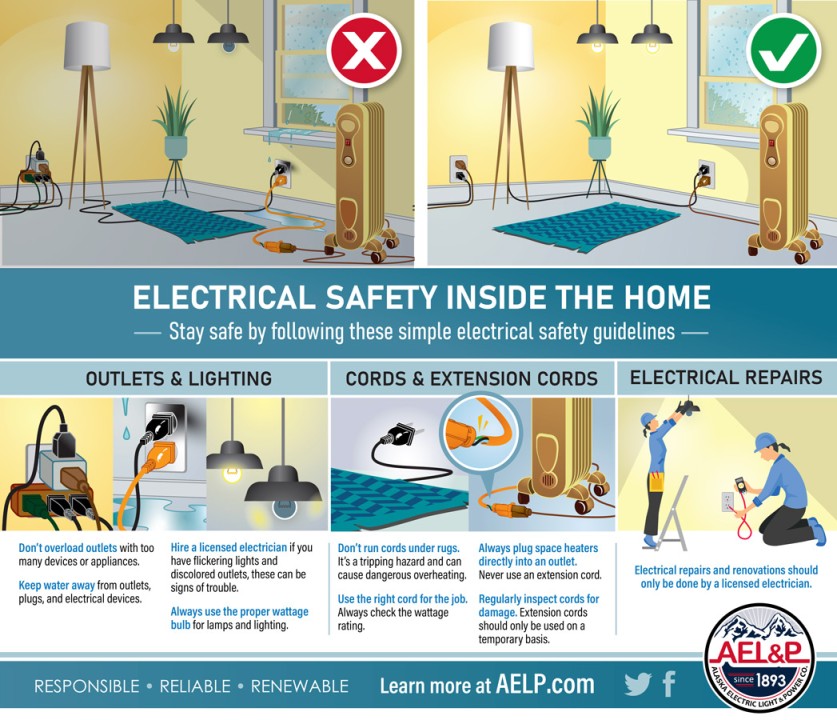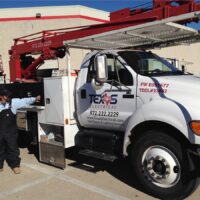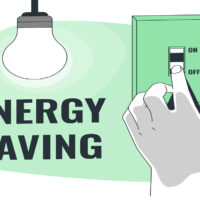Ensure electrical appliance safety by regularly inspecting for damage and following the manufacturer’s instructions. Unplug devices when not in use.
Electrical appliance safety is crucial for preventing accidents and ensuring a secure home environment. Regular inspections help identify wear and tear, reducing the risk of electrical fires. Following manufacturer guidelines ensures appliances operate as intended, maintaining their safety features. Unplugging devices when not in use prevents energy wastage and potential hazards.
Proper usage and maintenance of electrical appliances not only extend their lifespan but also protect your household. Always replace damaged cords and avoid overloading sockets. Educating all family members about safe practices ensures a collective effort in maintaining safety. Investing in quality appliances with safety certifications can further minimize risks. Safety should always be a top priority in every household.
Importance Of Safety
Electrical appliances make our lives easier and more comfortable. But, understanding the importance of safety is crucial. Unsafe electrical appliances can lead to accidents, fires, and even life-threatening situations. By adopting safety measures, we can protect our homes and loved ones.
Preventing Accidents
Preventing accidents with electrical appliances is vital. Here are some practical tips:
- Regular Inspections: Check wires and plugs for wear and tear.
- Proper Usage: Use appliances as per the manufacturer’s instructions.
- Avoid Overloading: Do not overload power outlets.
- Turn Off Unused Appliances: Unplug appliances when not in use.
Below is a table summarizing key actions to prevent accidents:
| Action | Description |
|---|---|
| Regular Inspections | Check for frayed wires and damaged plugs. |
| Proper Usage | Follow the manufacturer’s guidelines. |
| Avoid Overloading | Do not use too many appliances in one outlet. |
| Turn Off Unused Appliances | Unplug appliances when not in use. |
By following these tips, we can significantly reduce the risk of electrical accidents in our homes. Always stay cautious and prioritize safety.
Protecting Lives
Electrical safety does more than prevent accidents; it protects lives. Unsafe appliances can cause electric shocks and fires. Here are some steps to ensure safety:
- Use Grounded Outlets: Ensure outlets have three-prong sockets.
- Install Safety Devices: Use surge protectors and circuit breakers.
- Educate Family Members: Teach kids about electrical safety.
- Emergency Preparedness: Keep fire extinguishers and first-aid kits accessible.
Implementing these measures can safeguard lives:
- Grounded outlets prevent electric shocks.
- Safety devices cut power during surges.
- Education helps everyone understand risks.
- Being prepared for emergencies saves lives.
Protecting lives through electrical safety practices is essential. Prioritize these steps to ensure a safe living environment for everyone.

Credit: fr-fr.facebook.com
Common Electrical Hazards
Electrical appliances make our lives easier, but they can also pose serious risks. Common electrical hazards can lead to fires, injuries, or even fatalities. Understanding these hazards helps in preventing accidents and ensures a safer home.
Faulty Wiring
Faulty wiring is one of the leading causes of electrical hazards. It can result in electrical shocks, fires, and damage to appliances. Here are some signs of faulty wiring:
- Flickering lights
- Burning smell near outlets
- Discolored or charred outlets
- Frequent circuit breaker trips
Old or damaged wiring can degrade over time. This poses a significant risk. Regular inspections help identify these issues early. Professional electricians should handle all wiring repairs and replacements.
DIY electrical work is another source of faulty wiring. Untrained individuals can make mistakes that lead to hazards. Always hire a licensed electrician for any electrical work. This ensures safety and compliance with local codes.
Consider these tips for preventing faulty wiring:
- Schedule regular inspections every few years.
- Replace old wiring in older homes.
- Avoid overloading outlets with too many devices.
- Use surge protectors to protect appliances.
Overloaded Circuits
Overloaded circuits occur when too many devices draw power from a single circuit. This can cause the circuit breaker to trip or even start a fire. Signs of an overloaded circuit include:
- Frequent breaker trips
- Dimming lights
- Buzzing sounds from outlets
- Warm or hot outlets
To prevent overloaded circuits, distribute the load evenly across different circuits. Avoid using too many high-power devices on the same outlet. This reduces the risk of overheating and fire.
Use the following table as a guide to avoid overloading circuits:
| Device | Power Consumption |
|---|---|
| Refrigerator | 600-800 Watts |
| Microwave | 1000-1500 Watts |
| Electric Heater | 1500 Watts |
| TV | 100-400 Watts |
Tips to prevent overloaded circuits:
- Know the limits of your circuit’s capacity.
- Avoid daisy-chaining multiple power strips.
- Unplug devices not in use.
- Use energy-efficient appliances.
By understanding and mitigating common electrical hazards, you can create a safer environment for your family.
Safety Standards
Electrical appliances are a part of everyday life, making tasks easier and faster. But, they can be dangerous if not used correctly. Safety standards help ensure that these appliances are safe for use. These standards are set by various organizations to protect users from electrical hazards.
Regulatory Bodies
Several organizations establish and enforce safety standards for electrical appliances. These regulatory bodies ensure that manufacturers follow strict guidelines to keep consumers safe. Some key organizations include:
- Underwriters Laboratories (UL): UL tests and certifies electrical products to ensure they meet safety standards.
- International Electrotechnical Commission (IEC): IEC develops international standards for electrical, electronic, and related technologies.
- Consumer Product Safety Commission (CPSC): CPSC oversees the safety of consumer products in the United States.
- European Committee for Electrotechnical Standardization (CENELEC): CENELEC creates European standards for electrical equipment.
Each of these bodies has its own set of rules and guidelines. Manufacturers must get their products tested and certified by these organizations. This ensures that the appliances are safe to use. Certification marks from these bodies, like the UL mark or the CE mark, indicate that a product meets safety standards.
These regulatory bodies play a vital role in maintaining safety. They conduct regular inspections and tests. They also update their standards to match new technologies and risks. This continuous monitoring helps in preventing accidents and ensuring the well-being of users.
Compliance Guidelines
To meet safety standards, manufacturers must follow specific compliance guidelines. These guidelines cover various aspects of the product, including design, materials, and performance. Key guidelines include:
- Design Safety: Electrical appliances must be designed to prevent shocks, fires, and other hazards.
- Material Safety: Materials used in appliances should be non-toxic and flame-resistant.
- Performance Testing: Products must undergo rigorous testing to ensure they function safely under normal use.
- Labeling: Appliances must have clear labels indicating proper use and safety precautions.
- Instruction Manuals: Manufacturers must provide detailed manuals with safety instructions and warnings.
Manufacturers must document their compliance efforts. They keep records of tests, inspections, and certifications. This documentation is essential for regulatory audits. Non-compliance can result in severe penalties, including fines and product recalls.
Consumers should look for certification marks on electrical appliances. These marks indicate that the product meets safety standards. Following these guidelines helps prevent accidents and ensures the longevity of the appliances.
Proper Usage Tips
Electrical Appliance Safety is crucial in every household. Using appliances correctly not only extends their lifespan but also ensures the safety of your family. Here are some Proper Usage Tips to help you use your appliances safely and effectively.
Read Manuals
Always read the manual that comes with any electrical appliance. The manual provides specific instructions for safe usage. Here are some key points to look for in the manual:
- Installation Instructions: Ensure you follow the steps for correct installation. Incorrect installation can cause malfunctions or hazards.
- Operating Instructions: Learn how to operate the appliance as intended. Misuse can lead to accidents or damage.
- Maintenance Tips: Regular maintenance keeps your appliance running smoothly. Follow the recommended schedule for cleaning and servicing.
- Safety Warnings: Pay attention to all safety warnings. These warnings prevent potential risks like electrical shocks or fires.
Understanding the manual helps you avoid common mistakes. It also ensures you use the appliance as designed by the manufacturer. Here’s a quick table summarizing the key points to look for:
| Section | Importance |
|---|---|
| Installation Instructions | Prevents incorrect setup |
| Operating Instructions | Ensures proper use |
| Maintenance Tips | Extends appliance life |
| Safety Warnings | Prevents accidents |
Avoid Water Contact
Water and electricity are a dangerous mix. Keep electrical appliances away from water to prevent accidents. Here are some tips to ensure safety:
- Keep Appliances Dry: Always ensure your hands are dry before using an appliance. Wet hands can cause electrical shocks.
- Use Appliances Away from Sinks: Do not use electrical devices near sinks or bathtubs. Water splashes can cause short circuits.
- Store Safely: Store appliances in dry places. Avoid damp areas like bathrooms or basements.
- Immediate Action: If an appliance gets wet, unplug it immediately. Let it dry completely before using it again.
Keeping appliances dry is crucial for safety. It prevents electrical shocks and potential fires. Here’s a quick summary to remember:
- Dry hands before using.
- Keep away from sinks and bathtubs.
- Store in dry places.
- Unplug if wet and let dry.
By following these tips, you ensure that your home remains safe from electrical hazards. Proper usage of appliances helps in maintaining a safe environment for everyone.
Regular Maintenance
Electrical appliances are vital in our daily lives, making chores easier and life more comfortable. However, ensuring their safety is paramount. Regular maintenance of these appliances not only prolongs their lifespan but also protects your home from electrical hazards. This blog post will guide you through inspection schedules and the importance of professional services.
Inspection Schedules
Regular inspections are crucial to maintaining the safety and efficiency of your electrical appliances. Creating an inspection schedule helps you stay on top of potential issues before they become serious problems.
Here are some tips for setting up an effective inspection schedule:
- Monthly Checks: Look for visible signs of wear and tear. Inspect cords, plugs, and outlets for damage.
- Quarterly Checks: Test the functionality of safety features. Ensure smoke alarms and surge protectors are working.
- Yearly Checks: Perform a thorough inspection of all appliances. Check for any unusual noises or overheating.
To make it easier, consider using a table to track your inspections:
| Appliance | Monthly | Quarterly | Yearly |
|---|---|---|---|
| Refrigerator | Check door seals | Clean coils | Inspect overall condition |
| Microwave | Inspect door and seals | Test safety features | Check for unusual noises |
| Washing Machine | Check hoses | Clean filters | Inspect drum and motor |
Professional Services
While regular inspections can be done by anyone, some maintenance tasks require professional expertise. Hiring a professional ensures that your appliances are thoroughly checked and any hidden issues are identified.
Benefits of professional services include:
- Expert Knowledge: Professionals have the training to spot issues that might be missed by an untrained eye.
- Advanced Tools: They use specialized tools to diagnose and fix problems effectively.
- Safety Assurance: Professionals ensure that all repairs comply with safety standards, reducing risks of electrical hazards.
Here’s a simple guide to help you decide when to call a professional:
- If an appliance repeatedly trips circuit breakers.
- If you notice a burning smell or unusual noise.
- If the appliance is old and frequently malfunctions.
Keeping a record of professional services in a table can help you manage your appliance maintenance:
| Service Date | Appliance | Service Performed | Technician |
|---|---|---|---|
| 01/15/2023 | Refrigerator | Compressor Repair | John Doe |
| 03/20/2023 | Microwave | Door Seal Replacement | Jane Smith |
| 06/10/2023 | Washing Machine | Motor Repair | Bob Brown |

Credit: thecaregiversvoice.com
Child Safety Measures
Ensuring the safety of your children around electrical appliances is crucial. Young kids are naturally curious and can easily get into dangerous situations. Implementing child safety measures can prevent accidents and provide peace of mind. Focusing on essential aspects like outlet covers and educating children about risks can make a significant difference in household safety.
Outlet Covers
One of the simplest yet most effective ways to protect children from electrical hazards is by using outlet covers. These small devices can prevent young kids from inserting objects into electrical outlets, reducing the risk of electric shock.
Consider the following types of outlet covers:
- Plastic Plug Covers: These are inexpensive and easy to use. Simply insert them into unused outlets to block access.
- Sliding Plate Covers: These replace your standard outlet plates. The cover slides over the outlet when not in use, making it more secure.
- Box Covers: These are larger and cover the entire outlet, useful for outlets that are frequently used but need childproofing when not in use.
Here’s a comparison of different types of outlet covers:
| Type | Pros | Cons |
|---|---|---|
| Plastic Plug Covers | Cheap, Easy to Use | Can be a choking hazard if removed |
| Sliding Plate Covers | More secure, Permanent | Requires installation |
| Box Covers | Comprehensive protection | Bulky, More expensive |
Education On Risks
Teaching children about the dangers of electricity is equally important. Kids need to understand that electrical outlets and appliances are not toys.
Here are some effective ways to educate kids about electrical risks:
- Simple Explanations: Use simple language to explain what electricity is and why it’s dangerous.
- Role-Playing: Create scenarios where they practice safe behavior around electrical appliances.
- Interactive Activities: Use books, videos, and games designed to teach electrical safety.
- Consistent Reminders: Regularly remind them not to touch outlets or play with cords.
Parents can reinforce these lessons by setting a good example. Always practice safe behaviors yourself, such as unplugging appliances when not in use and keeping cords out of reach.
By combining physical safety measures like outlet covers with educational efforts, you can create a safer environment for your children. Start implementing these strategies today to protect your little ones from electrical hazards.
Emergency Preparedness
Electrical appliances make our lives easier. But they can also be dangerous if not used safely. Being prepared for emergencies can save lives and property. Let’s explore important steps for emergency preparedness in electrical appliance safety.
Fire Safety Plans
Having a fire safety plan is crucial. It helps you and your family stay safe in case of a fire. Here are some key points to include in your fire safety plan:
- Identify escape routes: Know two ways out of every room.
- Practice fire drills: Conduct drills twice a year.
- Install smoke alarms: Place them on every level of your home.
- Test smoke alarms monthly: Ensure they are working properly.
- Keep fire extinguishers handy: Place them in the kitchen and other key areas.
Here’s a quick table summarizing important fire safety tips:
| Action | Frequency |
|---|---|
| Check escape routes | Every 6 months |
| Conduct fire drills | Twice a year |
| Test smoke alarms | Monthly |
| Inspect fire extinguishers | Annually |
Remember to educate all family members on the fire safety plan. Make sure everyone knows how to use a fire extinguisher. Knowing these steps can help keep you safe during a fire emergency.
First Aid Kits
Having a first aid kit is essential. It helps you treat minor injuries quickly. Here are items you should include in your first aid kit:
- Adhesive bandages: For minor cuts and scrapes.
- Sterile gauze pads: To cover larger wounds.
- Antiseptic wipes: To clean wounds.
- Scissors: For cutting bandages or clothing.
- Instant cold packs: To reduce swelling.
- Tweezers: For removing splinters or debris.
- Gloves: To protect hands while treating injuries.
Here’s a table summarizing the contents of a well-stocked first aid kit:
| Item | Purpose |
|---|---|
| Adhesive bandages | Minor cuts and scrapes |
| Sterile gauze pads | Cover larger wounds |
| Antiseptic wipes | Clean wounds |
| Scissors | Cut bandages or clothing |
| Instant cold packs | Reduce swelling |
| Tweezers | Remove splinters or debris |
| Gloves | Protect hands |
Make sure your first aid kit is easily accessible. Check it regularly to replace any used or expired items. Being prepared with a first aid kit can help manage injuries effectively until professional help arrives.
Innovations In Safety
Electrical appliance safety has evolved significantly in recent years. Innovations in safety have made our homes smarter and safer. Manufacturers now incorporate advanced technologies to prevent accidents and ensure the well-being of users. Let’s explore some of these innovations.
Smart Appliances
Smart appliances have transformed our daily lives. They are designed with cutting-edge technology to enhance safety and efficiency. These appliances can connect to the internet, allowing users to control them remotely. This feature adds a layer of convenience and safety.
Here are some key benefits of smart appliances:
- Remote Monitoring: You can check the status of your appliances from anywhere using a smartphone app.
- Automatic Shut-Off: Smart appliances can turn off automatically if they detect a problem, reducing the risk of accidents.
- Energy Efficiency: These appliances use energy more efficiently, saving money and reducing environmental impact.
Consider the following table for examples of smart appliances:
| Appliance | Feature |
|---|---|
| Smart Refrigerator | Remote temperature control, door alarms |
| Smart Oven | Remote preheat, automatic shut-off |
| Smart Washing Machine | Remote start/stop, water usage monitoring |
Safety Features
Modern appliances come equipped with multiple safety features. These features are designed to prevent accidents and protect users from harm. Here are some of the most common safety features:
- Overheat Protection: Prevents the appliance from overheating, reducing fire risk.
- Child Lock: Prevents children from accidentally operating the appliance.
- Surge Protection: Protects the appliance from electrical surges that could cause damage.
These safety features are essential for ensuring the safe operation of electrical appliances. They provide peace of mind and help prevent accidents.
Here’s a table of common safety features in electrical appliances:
| Feature | Description |
|---|---|
| Overheat Protection | Shuts down the appliance if it gets too hot |
| Child Lock | Locks controls to prevent accidental use |
| Surge Protection | Prevents damage from electrical surges |
By incorporating these features, manufacturers ensure their products are safe and reliable. It is crucial for consumers to be aware of these innovations and choose appliances that prioritize safety.

Credit: www.linkedin.com
Frequently Asked Questions
How To Check Electrical Appliance Safety?
Regularly inspect for frayed cords and exposed wires. Unplug appliances when not in use. Ensure proper ventilation. Keep away from water.
What Are Common Electrical Appliance Hazards?
Common hazards include electric shocks, short circuits, and fires. Faulty wiring and overloaded outlets also pose significant risks.
How Often Should Appliances Be Serviced?
Service appliances annually or as recommended by the manufacturer. Regular maintenance ensures safety and efficiency.
Can Faulty Appliances Cause Fires?
Yes, faulty appliances can cause fires. Overheating, short circuits, and defective wiring are primary culprits.
Conclusion
Ensuring electrical appliance safety is crucial for every household. Regular maintenance can prevent accidents. Always follow manufacturer guidelines and use appliances responsibly. By staying vigilant, you protect your home and loved ones. Remember, safety starts with you. Prioritize these practices to enjoy a secure and hazard-free environment.




